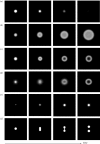Periodic versus scale-free patterns in dryland vegetation
- PMID: 20133355
- PMCID: PMC2871858
- DOI: 10.1098/rspb.2009.2208
Periodic versus scale-free patterns in dryland vegetation
Abstract
Two major forms of vegetation patterns have been observed in drylands: nearly periodic patterns with characteristic length scales, and amorphous, scale-free patterns with wide patch-size distributions. The emergence of scale-free patterns has been attributed to global competition over a limiting resource, but the physical and ecological origin of this phenomenon is not understood. Using a spatially explicit mathematical model for vegetation dynamics in water-limited systems, we unravel a general mechanism for global competition: fast spatial distribution of the water resource relative to processes that exploit or absorb it. We study two possible realizations of this mechanism and identify physical and ecological conditions for scale-free patterns. We conclude by discussing the implications of this study for interpreting signals of imminent desertification.
Figures


Similar articles
-
Ecological feedbacks. Termite mounds can increase the robustness of dryland ecosystems to climatic change.Science. 2015 Feb 6;347(6222):651-5. doi: 10.1126/science.1261487. Science. 2015. PMID: 25657247
-
Dryland ecosystems: the coupled stochastic dynamics of soil water and vegetation and the role of rainfall seasonality.Phys Rev E Stat Nonlin Soft Matter Phys. 2008 May;77(5 Pt 1):051908. doi: 10.1103/PhysRevE.77.051908. Epub 2008 May 13. Phys Rev E Stat Nonlin Soft Matter Phys. 2008. PMID: 18643103
-
Spatial decoupling of facilitation and competition at the origin of gapped vegetation patterns.Ecology. 2008 Jun;89(6):1521-31. doi: 10.1890/07-0365.1. Ecology. 2008. PMID: 18589517
-
A multi-scale perspective of water pulses in dryland ecosystems: climatology and ecohydrology of the western USA.Oecologia. 2004 Oct;141(2):269-81. doi: 10.1007/s00442-004-1570-y. Epub 2004 May 8. Oecologia. 2004. PMID: 15138879 Review.
-
Hydrologic variability in dryland regions: impacts on ecosystem dynamics and food security.Philos Trans R Soc Lond B Biol Sci. 2012 Nov 19;367(1606):3145-57. doi: 10.1098/rstb.2012.0016. Philos Trans R Soc Lond B Biol Sci. 2012. PMID: 23045712 Free PMC article. Review.
Cited by
-
The three regimes of spatial recovery.Ecology. 2019 Feb;100(2):e02586. doi: 10.1002/ecy.2586. Ecology. 2019. PMID: 30556129 Free PMC article.
-
Discovery of fairy circles in Australia supports self-organization theory.Proc Natl Acad Sci U S A. 2016 Mar 29;113(13):3551-6. doi: 10.1073/pnas.1522130113. Epub 2016 Mar 14. Proc Natl Acad Sci U S A. 2016. PMID: 26976567 Free PMC article.
-
Conservative or dissipative? Two distinct processes for spatial pattern emergence.Proc Natl Acad Sci U S A. 2023 Jan 31;120(5):e2221117120. doi: 10.1073/pnas.2221117120. Epub 2023 Jan 25. Proc Natl Acad Sci U S A. 2023. PMID: 36696441 Free PMC article. No abstract available.
-
Community plant height modulated by aridity promotes spatial vegetation patterns in Alxa plateau in Northwest China.Ecol Evol. 2023 Feb 14;13(2):e9823. doi: 10.1002/ece3.9823. eCollection 2023 Feb. Ecol Evol. 2023. PMID: 36818527 Free PMC article.
-
Comparison of CBERS-04, GF-1, and GF-2 Satellite Panchromatic Images for Mapping Quasi-Circular Vegetation Patches in the Yellow River Delta, China.Sensors (Basel). 2018 Aug 20;18(8):2733. doi: 10.3390/s18082733. Sensors (Basel). 2018. PMID: 30127272 Free PMC article.
References
-
- Barbier N., Coutron P., Lejoly J., Deblauwe V., Lejeune O.2006Self-organized vegetation patterning as a fingerprint of climate and human impact on semi-arid ecosystems. J. Ecol. 94, 537–547 (doi:10.1111/j.1365-2745.2006.01126.x) - DOI
-
- Barbier N., Coutron P., Lefever R., Deblauwe V., Lejune O.2008Spatial decoupling of facilitation and competition at the origin of gapped vegetation patterns. Ecology 89, 1521–1531 (doi:10.1890/07-0365.1) - DOI - PubMed
-
- Borgogno F., D'Odorico P., Laio F., Ridolfi L.2009Mathematical models of vegetation pattern formation in ecohydrology. Rev. Geophys. 47, RG1005 1–36 (doi:10.1029/2007RG000256) - DOI
-
- Campbell S. E., Seeler J. S., Glolubic S.1989Desert crust formation and soil stabilization. Arid Soil Res. Rehab. 3, 217–228
-
- Dekker S. C., Rietkerk M., Bierkens M. F. P.2007Coupling microscale vegetation-soil water and macroscale vegetation–precipitation feedbacks in semiarid ecosystems. Global Change Biol. 13(LO2402), 671–678 (doi:10.1111/j.1365-2486.2007.01327.x) - DOI
Publication types
MeSH terms
Substances
LinkOut - more resources
Full Text Sources

